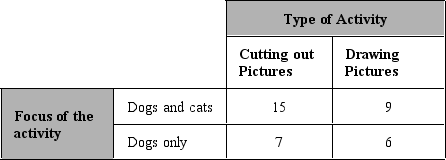Dr.Elder was interested in the way people recognize objects as members of categories.For example,what makes us recognize a dog as being a dog and not a cat? More specifically,he was curious as to whether people think about categories in a more complex way if they contemplate an "opposite" category first.For example,does a person think differently about the category of "southern" if they first think about the category of "northern"? He is also curious as to whether people categorize differently if they are exposed to category members compared with generating category members.Dr.Elder has four groups of participants (with 30 people in each group) .In Group A,participants were told to cut out pictures of dogs and cats from magazines.In Group B,participants were told to cut out pictures of just dogs from magazines.In Group C,participants were told to draw pictures of cats and dogs.In Group D,participants were told to draw pictures of just dogs.After doing this for 30 minutes,participants in all groups were asked to list the attributes that define the "dog" category.Having a higher number of attributes listed was considered to be an indication of thinking about the category in a more complex way.The results of his study are below.

-To make his study a 2×2×3 factorial design,which of the following would Dr.Elder need to do?
Definitions:
Nuclear Membrane
The lipid bilayer membrane which encloses the nucleus, separating its contents from the cytoplasm and regulating molecule passage.
Ribosomes
The cellular structures responsible for protein synthesis, found floating freely within the cytoplasm or attached to the endoplasmic reticulum.
Cellular Respiration
The metabolic process by which cells produce energy in the form of ATP from glucose, involving various biochemical pathways including glycolysis and the Krebs cycle.
Ribosomal RNA
A type of RNA that combines with proteins to form ribosomes, which are the cellular structures that assemble proteins according to genetic instructions.
Q7: Anton and his friends are discussing a
Q8: Why is there a publication bias against
Q8: In considering whether research is ethical, which
Q21: What is the principle of justice? Explain
Q32: How do reverse-worded items address shortcuts?<br>A)They slow
Q42: When a double-blind study is not possible,an
Q42: Which of the following is a NOT
Q58: Who is responsible for deciding which validity
Q60: A local committee that reviews research that
Q63: You read an article stating that Facebook